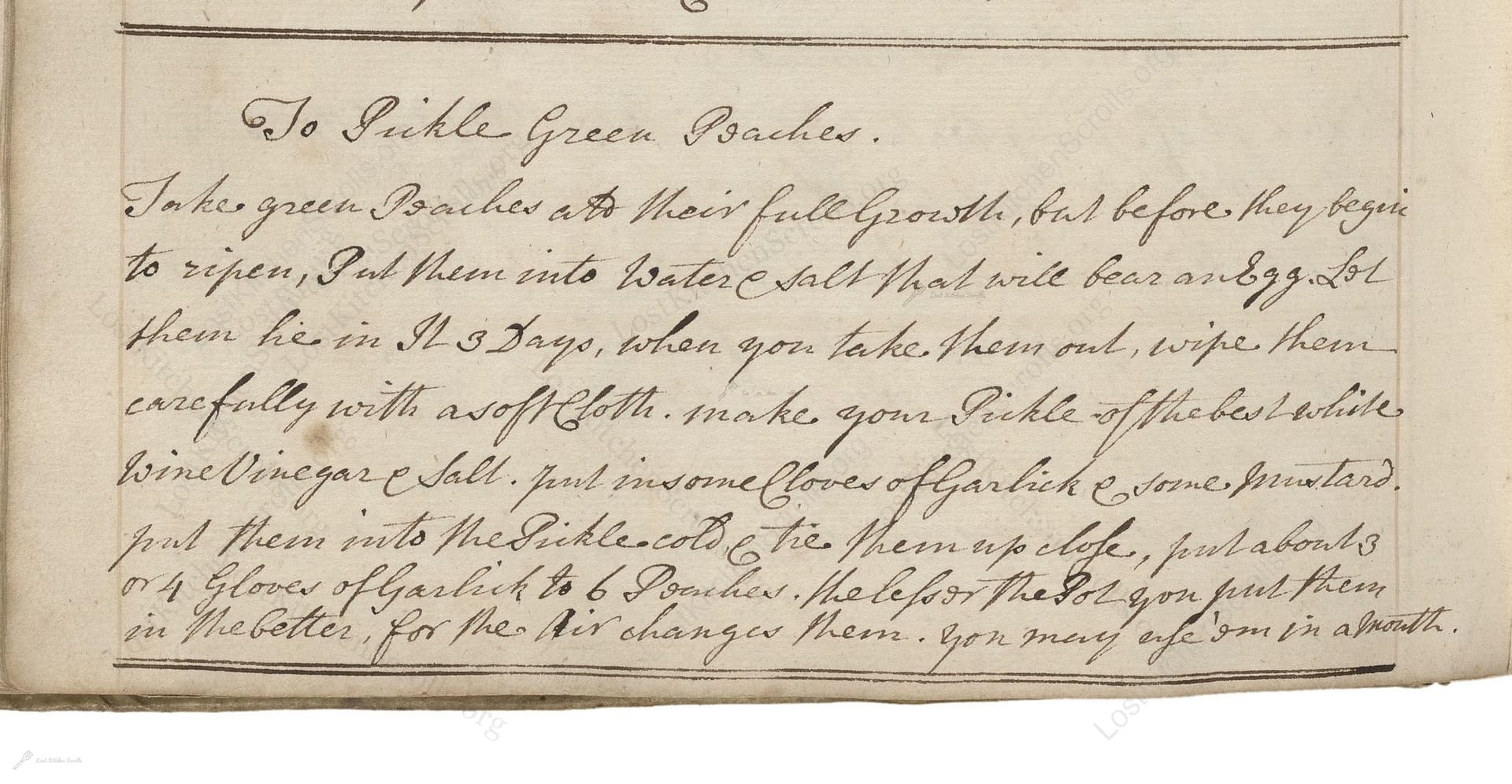To Pickle Green Peaches
From the treasured pages of Cookbook of 1725
Unknown Author

To Pickle Green Peaches
"Take green Peaches at their full Growth, but before they begin to ripen, Put them into Water & Salt that will bear an Egg. Let them lie in It 3 Days, when you take them out, wipe them carefully with a soft Cloth. Then make your Pickle of the best white Wine Vinegar & Salt. put in some Cloves of Garlick & Some Mustard. & tie them up close, put about 3 or 4 Gloves of Garlick to 6 Pound. The longer they lye in the Better, for the Air changes them. You may use them in a Month."
Note on the Original Text
Recipes of the period were written in a narrative, conversational style, with spelling and capitalization inconsistent by today’s standards (e.g., 'Peaches,' 'pickel,' and '&' for 'and'). Quantities were rarely precise—cooks were expected to adjust based on common kitchen knowledge and ingredient availability. Key terms like 'water & salt that will bear an egg' reflect traditional brining methods used to measure salinity before standardized scales and measurements.

Title
Cookbook of 1725 (1725)
You can also click the book image above to peruse the original tome
Writer
Unknown
Era
1725
Publisher
Unknown
Background
A delightful window into 18th-century kitchens, this historical culinary volume whisks readers away with its charming recipes and savory secrets from a bygone era.
Kindly made available by
Folger Shakespeare Library
This recipe comes from circa 1725 England, a period when pickling was a crucial means of preserving summer produce into the leaner winter months. Green, unripe peaches would have been available in abundance on estate orchards and provided a tangy, savory treat, especially prized at a time when fresh vegetables and fruits were not readily available year-round.

In the 18th century kitchen, cooks would have used large earthenware jars or wooden barrels for brining and pickling. A coarse linen or muslin cloth would be used for wiping the fruit dry. The vinegar and spices would be boiled in a copper or iron pan, and the final product would be sealed in glazed stoneware crocks or glass bottles, tied tightly with parchment and string to keep out air.
Prep Time
30 mins
Cook Time
0 mins
Servings
20
We've done our best to adapt this historical recipe for modern kitchens, but some details may still need refinement. We warmly welcome feedback from fellow cooks and culinary historians — your insights support the entire community!
Ingredients
- 6 lb firm, unripe green peaches
- 3.5 oz salt (for brine), plus 1.5–2 oz for the vinegar
- 2 qt white wine vinegar
- 3-4 cloves garlic
- 0.5 oz mustard seeds (or 1 tbsp yellow mustard seeds)
- Water, enough to cover peaches
- Optional: Substitute small immature apricots or green plums if green peaches are unavailable
Instructions
- Begin by selecting unripe green peaches, roughly at their full size but not yet turning color or softening.
- Prepare a brine by dissolving enough salt in water until a raw egg floats – this usually means about 3.5 ounces of salt per quart of water.
- Immerse the peaches in this brine for 3 days.
- Remove the peaches, rinse gently, and pat dry with a soft cloth.
- For your pickling solution, combine white wine vinegar (about 2 quarts for 6 pounds of peaches) with about 1.5-2 ounces of salt, 3 to 4 cloves of garlic, and a tablespoon (about 0.5 ounce) of yellow mustard seeds.
- Place the peaches in sterilized jars, pour over the spiced vinegar, and seal tightly.
- Store in a cool dark place for at least one month—the flavors develop even more over time.
Estimated Calories
25 per serving
Cooking Estimates
It takes a few minutes to prep the peaches, but most of the time is spent soaking them in brine and letting them pickle. Each serving is low in calories because the dish is mostly fruit and vinegar.
As noted above, we have made our best effort to translate and adapt this historical recipe for modern kitchens, taking into account ingredients nowadays, cooking techniques, measurements, and so on. However, historical recipes often contain assumptions that require interpretation.
We'd love for anyone to help improve these adaptations. Community contributions are highly welcome. If you have suggestions, corrections, or cooking tips based on your experience with this recipe, please share them below.
Join the Discussion
Rate This Recipe
Dietary Preference
Main Ingredients
Culinary Technique

Den Bockfisch In Einer Fleisch Suppen Zu Kochen
This recipe hails from a German manuscript cookbook compiled in 1696, a time whe...

Die Grieß Nudlen Zumachen
This recipe comes from a rather mysterious manuscript cookbook, penned anonymous...

Ein Boudain
This recipe comes from an anonymous German-language manuscript cookbook from 169...

Ein Gesaltzen Citroni
This recipe, dating from 1696, comes from an extensive anonymous German cookbook...
Browse our complete collection of time-honored recipes



